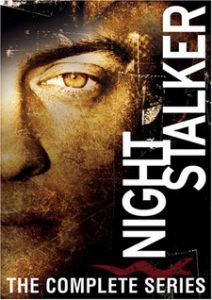“Night Stalker” (2005, ABC) was arguably the best of the “X-Files”-ish shows between “X-Files” (which ended in 2002) and “Fringe” (which started in 2008). It had the advantage of being helmed by Frank Spotnitz, Chris Carter’s second-in-command on “The X-Files,” and of being an update of the 1970s series “Kolchak: The Night Stalker,” which was a major influence on “The X-Files.”
Moody mysteries and Gabrielle Union
I loved “Night Stalker” even before it aired, and I loved it through the six episodes that aired on ABC and the four that followed on the Sci-Fi Channel. Of course I did. I like moody mysteries about things that go bump in the night, I like shows set in newsrooms (even if they aren’t entirely accurate), and I like Gabrielle Union.
Most vivid in my memory was “Night Stalker’s” stylish use of nighttime cinematography in the Beacon’s newsroom, which is halfway up a skyscraper, so we can see the lights and traffic of Los Angeles in the distance. That visual motif stood out on my re-watching of the DVDs, too.

“Night Stalker” (2005)
ABC, 10 episodes
Showrunner: Frank Spotnitz
Starring: Stuart Townsend, Gabrielle Union, Eric Jungmann
And Spotnitz, who had done “Robbery Homicide Division,” also highly praised for its visual style, notes on the DVD commentaries that “Night Stalker” was the only show at the time to make use of an actual nighttime cityscape to this degree.
Sticking with my praise of the show’s style: This may sound shallow, but Union — as by-the-book crime reporter Perri Reed — looks amazing. She’s not a bad actress by any means, but the folks behind this show really knew how to light her.
Meanwhile, Stuart Townsend, as unorthodox crime reporter Carl Kolchak, has a soft but firm voice that works well for an understated team leader. And Eric Jungmann, as photographer Jain McManus, is the somewhat-quirky glue that brings Kolchak and Reed together.
Sketchy newsgathering
Even in 2005, “Night Stalker’s” portrayal of a newsroom was inaccurate. Two crime reporters and a photographer working as a team at all times, even when merely following hunches? Unlikely, even on the very biggest papers, and this wasn’t one — the fictional Los Angeles Beacon played second fiddle to the Times.
And why is the newsroom dark in the evening? That’s when it should be at its busiest, as people are buzzing around getting the paper out for the next morning.
However, I’m not complaining about any of that. “Night Stalker” was clearly playing the style card, and those streams of traffic lights outside the window look so darn cool that I’ll give it a free pass. Plus, the idea of working a beat as a team is wonderful, if not monetarily realistic.
Furthermore, Spotnitz — a former reporter — did occasionally tackle Freedom of the Press issues, which are rarely explored on TV. Kolchak is thrown in jail for refusing to reveal a source. In the next episode, the Beacon editor (Cotter Smith) stands up to Agent Fain, telling him he won’t share his notes and photographs with investigators (also, he acknowledges that the Beacon’s parent company might not back him).
Trying to find a groove
Still, I can legitimately criticize these 10 episodes. The pilot is crunched into the standard 44 minutes; it felt that way when I watched it, and that feeling was reinforced when Spotnitz talked in the commentary about editing the pilot. Later episodes allow the show to breathe more, but I’m not sure the “Night Stalker” editors totally found their groove before it was canceled.
On “The X-Files,” Spotnitz masterminded (I know some people would use a different verb) the mythology, and he started to do that here, too, introducing invincible, killer ghost bikers and a mysterious mark on Kolchak’s wrist in a rather convoluted two-parter, “The Source” and “The Sea.”
A saving grace, certainly, is that we meet Edhead (Loreni Delgado), who is essentially the three Lone Gunmen rolled up into a better-looking package.
Missing monsters
As with “The X-Files,” I was more drawn to the monster-of-the-week episodes here. The deleted scenes of the hellhound attack in the pilot show that “Night Stalker” could’ve been much scarier than it actually was. The monsters were edited out at the network’s request, but it would’ve given all the episodes more bite if we knew real monsters could pop up at any time.
As it went on, the show — which always opened and ended with voiceovers from Kolchak — got more psychological. The final episode, “What’s the Frequency, Kolchak?,” teases us with the idea of a monster in a room at the end of a hallway, but we never see it.
There’s nothing necessarily wrong with that choice, but I believe “Night Stalker” should’ve had more monsters than it did; perhaps I’m influenced by the first incarnation of the series.
As it stands, “Night Stalker” left us with a great lead trio, a wonderful sense of style, 10 respectable episodes and boatloads of untapped potential. If “Miracles” was an interesting failure, “Night Stalker” was an interesting success — not quite as good as Spotnitz’s better-known show, but definitely a DVD I would recommend to “X-Files” fans.


